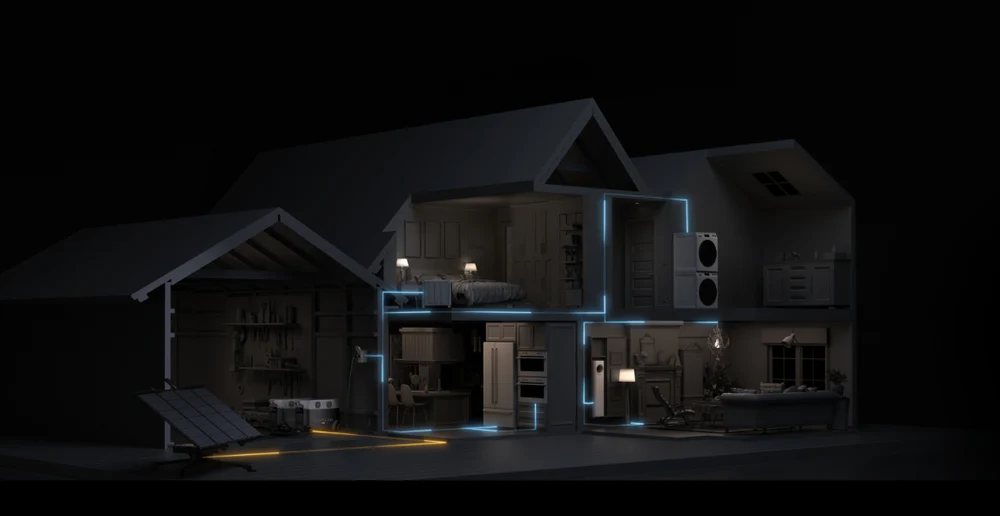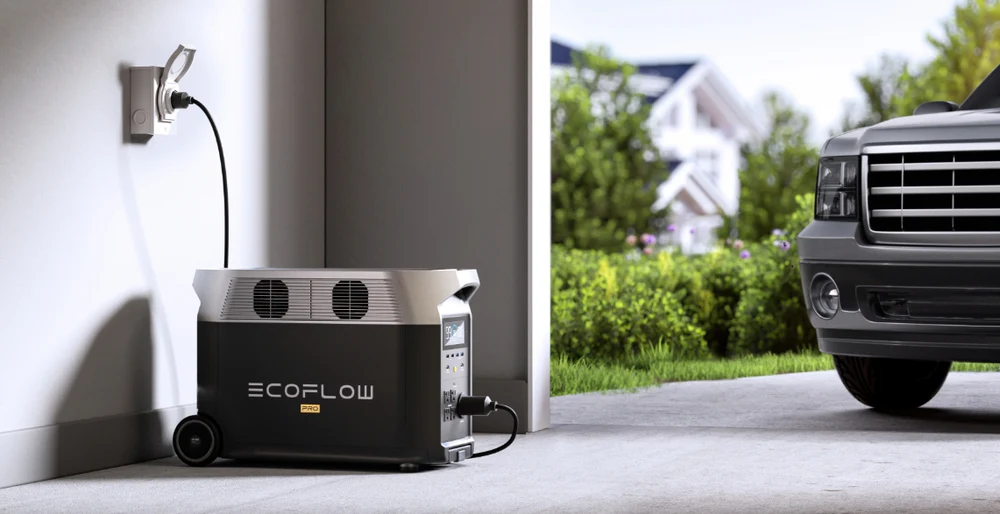Key Factors for Choosing Solar Battery Banks for Home Energy Storage
Across Canada, more households are turning to solar energy not just for environmental benefits, but also for greater independence from the grid, lower electricity bills, and reliable backup when the power goes out. A solar battery bank is at the heart of this setup, storing excess energy from panels during the day so it can be used whenever you need it, whether that’s in the evening, during peak pricing hours, or in the middle of a blackout.
But selecting the right battery bank isn’t as simple as buying the first system you see. It requires careful thought about your household’s energy needs, your budget, and the type of technology that best matches your lifestyle. In this guide, we’ll break down why solar storage is becoming more important, the key factors to consider when choosing a battery bank, and when a more flexible option, such as a portable power station, may actually make more sense.
Why Residential Solar Energy Storage is Essential
Residential solar battery banks are far more than optional add-ons. They enhance both the value and reliability of a home solar system, turning panels into a complete energy solution. Here are three of the most important benefits.
Power During Outages
Power failures can strike without notice, whether caused by summer thunderstorms, winter ice, or unexpected grid issues. A solar battery bank ensures your home can keep critical systems running, from refrigerators and sump pumps to medical equipment and lighting. For Canadians living in regions with harsh weather or rural areas where outages are more common, this resilience can provide both comfort and peace of mind. A solar generator can also serve a similar role, offering portable backup power for specific needs.
Lower Electricity Bills
Storing excess solar power allows you to use it later, especially during peak pricing hours when utility rates are highest. Instead of paying for grid electricity in the evening, you can draw from your own stored energy. Over time, this strategy reduces monthly bills and increases the long-term return on your solar investment.
Protection From Rising Prices
Electricity costs continue to rise across much of Canada, and market volatility makes it difficult for households to plan around future bills. With a battery bank, you can store power when it’s cheapest or, better yet, directly from your solar panels and rely less on grid energy. This helps stabilize household expenses while giving you more control over your energy use.


How to Choose a Solar Battery Pack
Selecting the right solar battery pack involves more than comparing price tags. To make the most of your investment, it’s important to weigh your household’s needs against the technology and features available. Here are the key factors to consider.
Determine Your Power Requirements
Begin by calculating how much energy your household actually uses during both everyday operation and emergencies. Think about which appliances matter most, such as refrigerators, sump pumps, Wi-Fi routers, or medical equipment, and how long you would want them to run during an outage. This helps ensure you choose a battery that can deliver steady support when it’s needed most.
Consider Battery Capacity and Storage
Capacity, measured in kilowatt-hours (kWh), indicates how much electricity a battery can hold. A modest-capacity pack may cover evening use or a short blackout, while larger households or families aiming to stay off grid for longer periods may need more storage to power multiple appliances over several days.
Check Battery Chemistry and Technology
Most modern solar batteries use lithium-ion technology, which is lighter, more efficient, and longer lasting than older lead-acid models. Within this category, lithium iron phosphate (LiFePO₄) batteries stand out for their durability and safety, making them a popular choice for residential storage. As part of a guide to solar battery chemistry, understanding these differences can help homeowners choose the right battery for performance, lifespan, and safety.


Evaluate Battery Life and Warranty
Every battery gradually degrades with use, so it’s important to check the rated cycle life, the number of times it can be charged and discharged before capacity drops significantly. A solid manufacturer’s warranty not only extends peace of mind but also reflects confidence in the product’s longevity.
Compatibility with Your Solar System
Not every battery works seamlessly with all inverters or solar setups. Before purchasing, confirm that the pack you’re considering integrates smoothly with your system, especially if you plan to expand your panels or upgrade equipment later.
Efficiency and Charge
Round-trip efficiency measures how much of the electricity stored in the battery remains usable after charging and discharging. Higher efficiency means you get to use more of the solar energy your panels produce, reducing waste and maximizing savings. Fast charging capabilities can also make a difference if you want a system that quickly recovers during daylight hours or after a prolonged outage.
Solar Battery Banks vs Portable Power Station
Solar battery banks remain the gold standard for homeowners who want a permanent, integrated energy storage system. At the same time, portable power stations have become increasingly popular in Canada thanks to their versatility and ease of use. Here’s how the two compare.
Capacity and Power Output Comparison
Solar battery banks are designed for whole-home use, offering large storage capacity to cover multiple appliances and even days of energy demand. Portable power stations vary widely: smaller models are well-suited for charging phones, laptops, or camping gear, while larger systems, such as the EcoFlow DELTA Pro, can handle high-wattage appliances and even support partial or full home backup.
Portability and Size
A stationary battery bank is installed in one location, typically in a garage, basement, or utility room. It’s built to last but not to move. Portable power stations, by contrast, are exactly that, portable. They can be rolled between rooms, brought along on RV trips, or carried to cottages, making them especially valuable for Canadians who split time between city homes and seasonal retreats.
Charging and Recharge Time
Solar battery banks are primarily tied to your solar panels for charging. While efficient, this can be a limitation during cloudy weather or overnight. Portable power stations often support multiple charging methods. For instance, the EcoFlow DELTA Pro Portable Power Station can be recharged through solar panels, standard wall outlets, EV stations, or EcoFlow’s Smart Generator. With up to 6500W of MultiCharge input, it offers much faster and more reliable recharge options, ensuring you’re not left waiting for sunlight when you need power most.
Use Cases and Applications
Solar battery banks are best suited for homeowners who want a stable, long-term storage solution tied directly to a fixed solar system. They shine in households with consistent sun exposure and a clear goal of reducing grid reliance. The main drawback, however, is their dependence on solar charging alone, which can be less reliable during cloudy stretches or overnight; this is something Canadians in northern regions know all too well.
Portable power stations, by contrast, are built for flexibility. They can serve as both everyday companions and emergency lifelines. A strong example is the EcoFlow DELTA Pro Portable Power Station, which goes beyond solar-only charging by also supporting AC wall outlets, EV chargers, and EcoFlow’s Smart Generator. With a massive 6500W MultiCharge capacity, it can power an entire home during an outage, yet still be rolled out to the cottage, packed for camping, or kept on hand for winter storm preparedness. This adaptability makes portable stations especially appealing for Canadian households looking for a solution that works year-round and across multiple settings.
Maintenance and Lifespan
Stationary solar banks typically require professional installation, monitoring, and occasional servicing to ensure long-term performance. A portable power station, on the other hand, demands little upkeep. They can be replaced or upgraded more easily, though they may not last as long as the highest capacity residential units. For many households, the trade-off is worthwhile given the flexibility and lower entry cost.
To make the differences even clearer, we’ve put together a side-by-side comparison of solar battery banks and portable power stations. This chart highlights their strengths, limitations, and best use cases, and is provided as a quick reference to help you decide which option fits your household or lifestyle best.
| Feature | Solar Battery Banks | Portable Power Stations |
|---|---|---|
| Capacity & Power Output | Typically larger capacity, designed for whole-home energy storage; ideal for long-term use | Moderate capacity, suitable for powering essential devices and small appliances |
| Portability & Size | Fixed installation, heavy, and not portable | Compact and portable, easy to carry for outdoor or emergency use |
| Charging & Recharge Time | Dependent on solar input; slower if sunlight is limited | Supports multiple charging methods (AC outlet, solar, car), usually faster and more flexible |
| Use Cases & Applications | Best for residential backup, bill reduction, and long-term storage | Ideal for camping, outdoor activities, short-term outages, or mobile power needs |
| Maintenance & Lifespan | Longer lifespan (10–15 years), but requires professional installation and system checks | Minimal maintenance, plug-and-play design, generally shorter lifespan than home storage systems |


How to Install and Connect Solar Storage
Installing a solar storage system is a technical process that should always follow safety standards, building codes, and manufacturer instructions. While every setup is unique, the following steps outline the core elements of a proper installation.
Connecting the Inverter to the Battery Bank
The inverter is the heart of your system, converting the stored DC energy in your battery into AC power for household use. A secure and properly configured connection between the inverter and the battery ensures energy flows efficiently and reliably into your home’s circuits.
Wiring and Electrical Safety Considerations
All wiring must comply with Canadian Electrical Code requirements. Using the correct wire gauge, protective breakers, and proper grounding methods reduces the risk of overheating and electrical hazards. Attention to these details is essential for both performance and safety.
Installing the Battery Management System
A Battery Management System regulates how your battery charges and discharges, protecting it against overcharging, deep discharges, and overheating. This system is vital for extending battery life and maintaining safe operation under different conditions.
Testing and Monitoring the System After Installation
Once the system is in place, it should be tested under various loads to confirm proper function. Modern storage units often include monitoring tools through apps or control panels, giving you real-time insight into performance, efficiency, and potential issues before they become serious problems.
Troubleshooting Common Installation Issues
If you encounter problems such as sudden shutdowns, low efficiency, or unusual system behaviour, the root cause is often wiring errors, incorrect inverter settings, or compatibility mismatches. Following the complete guide to solar inverters and opting for professional installation greatly reduces these risks, ensuring your system operates safely and effectively.
Conclusion
Solar battery banks are a strong investment for Canadian households looking for reliable backup power, lower electricity bills, and a safeguard against rising energy costs. By integrating directly with rooftop panels, they turn renewable energy into a dependable part of daily life, ensuring that excess solar power is never wasted.
At the same time, portable power stations such as the EcoFlow DELTA Pro offer a level of flexibility that fixed systems can’t match. With multiple charging options and whole-home backup capacity, they overcome the limits of solar-only storage and prove just as useful for camping trips, cottages, and seasonal preparedness as they are during unexpected outages. Ultimately, the choice comes down to your energy needs, budget, and lifestyle. By carefully weighing these factors, you can select the solution that delivers not only practical savings but also long-term peace of mind.
FAQ
Is a Solar Battery Bank Worth the High Initial Cost?
Yes. While the upfront cost of a solar battery bank can be significant, the long-term benefits are substantial. By storing excess solar energy, you can reduce monthly electricity bills, avoid expensive peak-hour rates, and keep critical appliances running during outages. A battery bank also protects against rising energy costs and increases your household’s energy independence. For homes that experience frequent blackouts, face high utility charges, or plan to expand their solar capacity, the investment often pays for itself within just a few years, making it both a practical and valuable addition to a residential solar setup.
How Long Will a Solar Storage Solution Last?
Most modern solar batteries last between 10 and 15 years, depending on the type of chemistry, how often they’re used, and how well they’re maintained. Lithium-ion batteries generally outperform lead-acid models, offering higher efficiency, longer cycle life, and less required maintenance. Many premium systems now come with 10-year warranties, giving homeowners added peace of mind. Proper installation, regular monitoring, and avoiding deep discharges can further extend lifespan. Newer technologies like Lithium Iron Phosphate (LFP) are especially popular for residential storage, thanks to their improved safety, stability, and durability.
Do I Need an Off-Grid Solar Battery for Backup?
Not necessarily. Even grid-connected homes can benefit from a solar battery, since it provides backup power during outages, reduces reliance on the grid during peak pricing hours, and helps buffer against grid instability. Off-grid batteries are most valuable for remote locations, cottages, or cabins where access to the utility grid is limited or unavailable. For most households, however, a hybrid approach, grid-tied solar panels paired with a battery bank, offers the best balance. This setup delivers daily energy savings, emergency backup, and long-term flexibility without requiring a complete off-grid system.
Is Professional Installation Required for a Residential Solar Battery System?
Yes. Professional installation is strongly recommended, and in most cases essential for residential solar battery systems. These setups involve advanced electrical wiring, inverters, and integration with your home’s existing solar or electrical panel. Attempting a DIY installation can create serious safety hazards, including fire risk, electrocution, or premature system failure. It may also void manufacturer warranties or violate provincial electrical codes. Certified installers ensure that your system is configured correctly, compliant with Canadian building standards, and optimized for both safety and efficiency.